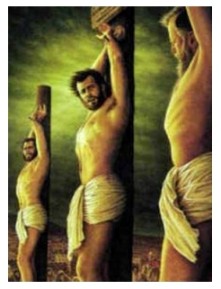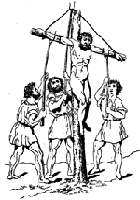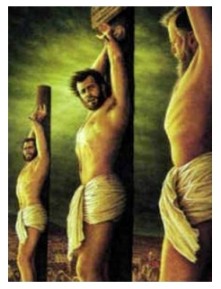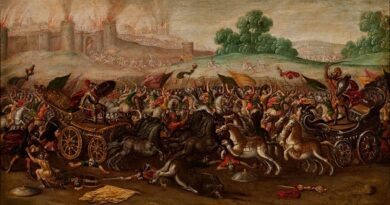New Findings On The Way How Jesus Died
Scientific experiments carried out in 1948 by the Austrian physician Herman Moeddler showed that a person hung by his hands nailed directly overhead dies of suffocation in about 6 minutes. If it hung on the other hand nailed with arms extended at an angle of 60-70 degrees, which occurred at regular crucifixion, escapes the victim to suffocate and can remain alive for several hours. These experiments were confirmed by Frederick T. Zugibe, Professor of pathology at the University of Columbia, and presented in the magazine Bible Review, April 1989, pp. 35-43. The article is called “Two Questions About Crucifiction: Does the Victim Die of Asphyxiation? Would Nails in the Hand Hold the Weight of the Body?” The careful research published also show that the nails do not need to have gone through the wrists to the body would remain hanging but that there are areas in the palms where the nails could be fixed and can carry hundreds of kilograms.
Cross or Stake?
 In The Watchtower 1989 May 1, p. 23 (and other publications), Watch Tower organization makes the claim that Jesus died, not on a cross but on a single pole and that the cross is a pagan, idolatrous symbol. This approach has the Watchtower Society had since 1936. They cite the elementary meaning of the Greek word staurós and xýlon used in the NT. It also cites some scholars from the 1800s and the turn of the century who share their view. It has even suggested that the notion that Jesus died on a “cross” – a pole with a cross bar – is only a religious tradition from the Emperor Constantine. (Kingdom Interlinear, 1969, p. 1155) thus considered that the matter is settled.
In The Watchtower 1989 May 1, p. 23 (and other publications), Watch Tower organization makes the claim that Jesus died, not on a cross but on a single pole and that the cross is a pagan, idolatrous symbol. This approach has the Watchtower Society had since 1936. They cite the elementary meaning of the Greek word staurós and xýlon used in the NT. It also cites some scholars from the 1800s and the turn of the century who share their view. It has even suggested that the notion that Jesus died on a “cross” – a pole with a cross bar – is only a religious tradition from the Emperor Constantine. (Kingdom Interlinear, 1969, p. 1155) thus considered that the matter is settled.

Staurós and xýlon
But the reality is different. To begin with, it is wrong to suggest that the very words staurós and xýlon prove anything. Both of these words fit in fact, both “simple” execution piles of crosses. The Society recognizes that the Romans carried out the executions not only on simple piles but also on stilts crossbar. (Awake! July 22, 1963, p. 21)
To a crossbar affixed to the upright pole did not think it ceased to be called stauros or xýlon. The Society admits indeed that the word stauros “is sometimes also used for cross-shaped object”. (Awake! March 22, 1977 p. 21) But such recognition does not regard the word xýlon:
“Although the word staurós, it is only used by the Gospel writers as it related to what Jesus hung on, can mean either a simple stake or a cross, indicating the fact that the Bible elsewhere speaks of it as a xýlon, which simply means a piece of wood and has no dual meaning, that kind of stauros on which Jesus died, was not a cross. ” (Awake! July 22, 1963, p. 22)
Society has utterly wrong. Dictionaries informs that xýlon could stand for “anything that is made of wood.” (Friedrich – Bromiley, Theological Dictionary of New Testament Words, Vol. 5, 1967 p. 1176) It could mean “hanger” (Walther Bauer`s A Greek-English Lexicon of the New Testament, 2nd edition, 1958, p. 549), and used even if such a complicated wooden structures like benches and tables. (Friedrich-Bromiley, p. 1176). In the Septuagint translation of the Old Testament used xýlon even if living tree with branches and everything! See, for. Ex Jes.7:2 and Jer. 2:20, LXX. Therefore, there is absolutely nothing to prevent the word xýlon used as an execution stake with crossbar.
And so it was with words stauros and xýlon and even the Latin word crux in antiquity. Crux meant originally a single-pole, but when the Romans applied a crossbar on the gallows called execution tool is still the crux.
To understand this we need only think of our modern world poles. A telephone pole is a telephone pole, although it often involves a veritable “buzz cross”, a pole cross arms and bodies!
Indications in the NT
One can not in fact on linguistic grounds to decide what form the “cross” was in Jesus’ case. But, some information in the NT actually give clear directions on how Jesus ‘cross’ was constituted. John 20:25, shows that Jesus’ hands was pierced by at least two nails. Thus, the Society’s illustrations that show that Jesus’ hands nailed with a single nail rejected. Information is correct, however well with the traditional view of the crucifixion. Moreover, says Matt. 27:37 Romans set up a heading or sign over Jesus’ head. Jesus had his hands outstretched to the side is the best explanation for this circumstance. If he had had his hands nailed above his head as the Watchtower illustrations show, it would undoubtedly have been named in the text of the caption was up over his hands instead of his head! JWs leadership cites the book The Non-Christian Cross (1896), in which John Denham Parsons, states that “There is not a single sentence in any of the numerous writings forming the New Testament, which, in the original Greek, bears even indirect evidence to the effect that the stauros used in the case of Jesus was other than an ordinary stauros; let alone any evidence that it consisted of a single piece of wood, but of two pieces that were nailed together into a cross. “(Reasoning on the Scriptures, 1995, p. 211)
Early testimony
If now the indirect testimony of the NT proves that Jesus died on a traditional cross ought to finas early testimony confirming this. And it is so! While there is no early indication that Jesus would have died on a simple pole, there are strong early testimony that He died on a pole with a crossbar, a cross. This view arose not at first at the Emperor Constantine. Already Justin Martyr, who had lived in Palestine, describing the kind of cross that Jesus died on. In his “Dialogue with Tryfo” he wrote around 160 AD:
“One beam is maintained, and from this projecting upper up like a horn when the second beam is attached to it, and the ends are visible on both sides like horn which is attached to the first flange. And the part which is affixed in the center and carrying out those who were crucified, also stands out like a horn. ” (The Ante-Nicene Fathers, Vol. I, Eerdmans, 1977, p. 245)
Some decades later wrote the Christian writer Irenaeus:
“The very form of the cross, too, has five extremities, two in length, two in breadth, and one in the middle, on which [last] the person rests who is fixed by the nails.” (Ibid, p. 395)
In the year 197 AD wrote the prolific Christian writer Tertullian in the work “Ad Nationes“:
“Every hour piece that is attached to the ground in upprött position is part of a cross, indeed, the greater part of its mass. But the whole cross attributed to us, with its crossbeam of course, and its protruding seat.” (The Ante-Nicene Fathers, Vol. III, Eerdmans, 1978, p. 122)
These three early Christian writers willing to cite the Society when they support their beliefs. (See eg Watchtower October 15, 1981, s.10,11) But when it comes to the descriptions of the Cross, the organization has no use for them. It rejects even Justin Martyr’s task as not inspired! (Awake! March 22, 1977, p. 21)
However, one can not reject such early, consistent testimony. Justin, Irenaeus and Tertullian had undoubtedly greater potential than we have to know how the cross of Jesus looked like. They lived moreover at a time when crucifixion still practiced! Both Justin and Tertullian warns that Christians regularly hit by these cruel punishment. (The Ante-Nicene Fathers, Vol. I, p. 254; Vol. III, p. 28)
Cross associated with the letter T.
Already in the Christian so-called Epistle of Barnabas, which was not written later than 138 e.Kr (according to some researchers as early on about 75 e.Kr), speaks of the “cross, which is indicated in the letter T.” (The Apostolic Fathers, Andren and Beskow, Stockholm, 1992, pp. 157, 172; for the early dating, see John A. T. Robinson, Redating the New Testament, London, 1976. pp. 312-319)
This was not just a Christian idea. The Greek writer Lucian, who lived about 120-180 e.Kr, says the letter T had their ‘evil significance “of the” bad instrument “that tyrants uppställde to hang people:
“They say that their tyrants, follow him and imitate his form, have attached the logs in the same form and crucify the people on them.” (Iudicium Vocalium 12, cierad of Martin Hengel in the book Crucifixion, Fortress Press, 1982, pp. 8, 9)
The Witness of the Bible Manuscripts
These descriptions have a märkigt way confirmed in our century of newfound Bible manuscripts. The “P 75”, a papyrus manuscript of the NT that has long been dated to c. 200 e.Kr, written word stauros together in three places in the text so that the letters T and R together form a cross with a body on! We reproduce here a reproduction from W. F. Becks American Bible translation (1976) which clearly demonstrates this. The famous manuscript “P 66” from about the same time do the same in a cross in the word stauros. (See Jack Finegan, Encountering New Testament Manuscripts, Eerdmans, 1980, p. 33).

These strange manuscripts may be much older than previously thought. A researcher has recently paleografiska grounds omdaterat the related manuscript “P 46” to the latter part of the first century. (Biblica, Vol. 69: 2, 1988, s.248-257) Professor George Howard of the United States wrote to us that P75 and P66 “not long after P46 in terms of dating.” (Letter of 8 July 1988). So, these manuscripts testify therefore strongly that Christians from the very beginning been convinced that Jesus died on a pole with a cross bar, a composite cross.
A Pagan Symbol?
The Society’s Kingdom Interlinear Translation of the NT in 1969 we find on page 1157: “We refuse to add anything to God’s written Word by inserting the pagan cross into the inspired Scriptures.” It also says here that “torture stake” is “the cleanest” translation of “stauros”. The Watchtower, Sept. 1. 1951, p. 403, it is said that Jesus “never hung in any pagan cross of phallic origin.” In the Awake! November 8, 1964, p. 10, says that the cross symbol of Christianity “is a remnant of ancient phallic worship”.
But really would a pole to be a “cleaner”, small phallus emphasized the instrument of execution than a cross? Nothing! Notice what the Watchtower November 15, 1974 says on page 525:
“Over the whole of Canaan, there were shrines in honor of Baal. … Near the altars outside the sanctuaries there were altars, sacred piles (which represented the goddess Asherah) and rökelsealtaren. Both the sacred pillars and sacred poles were sexual symbols.”
See also the “grove” in the glossary at the 1917 translation of the Bible and the word “Sacred Pole” in the Aid-book (1971), pp. 1428-1429 and Insight-book (1988), Vol.2, pp. 835-836.
Also note what the Awake! November 8 1964 says on page 8 of pillars and piles of the Roman Empire:
“In the Roman Empire, as in other parts of the ancient world, were phallic worship popular. Phallic worshipers depicted the male könsorgandet lifelike statues in public places and on the walls and on the floors of the Roman homes. It also prepared by upright pillars, stones and piles, such as those worshiped by the people of the east.”
In the same article asserts Society that such objects are still used as phallic symbols in India: “Upright objects such as statues, pillars, towers, rocks, hills, piles and so on represent the linga of phallic worshipers.” (p. 11)
You win because not one iota of replacing the “cross” with the “pole” in a Bible translation. The pile was as much a phallic symbol that ever cross. When the Romans executed people on stilts and the cross was also no question of any religious rites with phallic symbols. It was simply practical considerations decided. This has incidentally been with several objects and structures in appearance would remind you of things associated with sex worship. Would Society logic applied consistently would even its own vakttornssymol be classified as a phallic symbol! But this would be as absurd as to say that the Roman instrument of execution were phallic symbols.
Jesus did not choose the shape of the instrument of execution, he died. The Romans settled the matter. The Christian need not be ashamed of the cross of Jesus. “To the pure all things are pure, but to those who live in filth and amazingly, nothing is pure.” (Titus 1:15, NWT-81)
Need to be different
For the Christian, it is obviously immaterial whether Jesus died on a cross or a pole. It is his atoning death that is important. It is the Watchtower Society who have made a business out of this matter. As we have seen, there is conclusive evidence for the view that Jesus died on a cross. Why persist when the party in saying that he was “in all probability” was “executed on an upright pole without a crossbar”? (The Watchtower August 15, 1987, p. 29)
The reason is certainly the need to have to distance themselves from the churches and finding reasons to carp at them. It is part of the Society’s campaign to create hatred for churches and highlighting their own organization, so that they can beat their chests and say, “Christianity is composed of phallic worshipers. It is only we who reject the pagan cross. Therefore, only we have the truth. ”
The Society is so highly motivated in their stance against the cross that it has lost its objectivity. They want to see things in a certain way. How preconceptions can blur the review describes Nicholas Kip, one of the Watchtower philologists in Awake! 22 March 1987, page 13:
“Such preconceptions can really give a eyes that do not see and ears that do not hear, for if, when doing his research, looking for something to confirm what you already believe, this is all that one’s eyes and ears will be seeing and hearing. Instead of searching see all the facts they see only that which can be used or misused to support their preconceived ideas. “
How true is this in terms of Society’s attitude to the cross!

At the crucifixion often had criminal himself carry the crossbeam, the so-called “patibulum”, to the execution site. Which was tied or nailed criminal on the cross-beam, which is then attached on the stake. The image above is taken from the book Das Kreuz und die Kreuzigung [The Cross and the Crucifixion], by Hermann Fulda, Breslau 1878, Tab.4.



